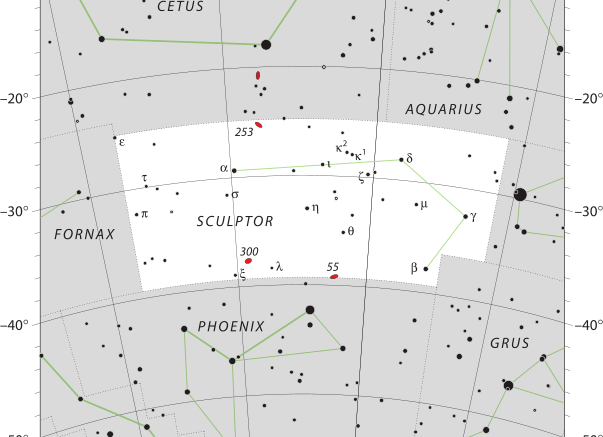Located in the southern sky, Sculptor is a small and faint constellation, which represents a sculptor. The constellation was introduced by Nicolas Louis de Lacaille in the 18th century with the original name of Apparatus Sculptoris. Apparatus Sculptoris translates to the sculptor’s studio, but the name was later shortened to the name we are familiar with today.
The whole constellation is visible to observers south of latitude 50°N, which will include those living in the Pacific Northwest..
| Applicable Information | |
| Visibility In Pacific Northwest | August to November |
| Best Times To View | September |
| Right Ascension | 0h |
| Declination | −30° |
| Area | 475 square degrees |
| Main Stars | 4 |
| Brightest Object | 30° |
| Meteor showers | 0 |
| Messier objects | 0 |
| Neighboring Constellations | Cetus, Aquarius, Piscis Austrinus, Grus, Phoenix, Fornax |
History
In ancient times, the region to the south of Cetus and Aquarius had been named The Waters by Aratus in 270 BC.
The first modern description of the constellation was done by French astronomer Nicolas-Louis de Lacaille in 1751 or 17552.
Stars
The constellation does not contain stars brighter than the 3rd magnitude, which is because Sculptor contains the south galactic pole. This means that the stellar density in this constellation and star mass is very low.Within the constellations borders, there are 56 stars that are brighter than or equal to an apparent magnitude of 6.5.
The brightest star is Alpha Sculptoris, which is an SX Arietis-type variable star.
Eta Sculptoris is a red giant of spectral type M4III that varies between magnitudes 4.8 and 4.9.
R Sculptoris is a red giant that has been found to be surrounded by spirals of matter likely ejected around 1800 years ago.
Deep sky objects
The constellation also contains the Sculptor Dwarf, which is a dwarf galaxy that is a member of the Local Group. There is the Sculptor Group, which is a group of galaxies closest to the Local Group. The Sculptor Galaxy, otherwise known as NGC 253, is a barred spiral galaxy and the largest member of the group that can be found near the border between Sculptor and Cetus. Another prominent member of the group is the irregular galaxy NGC 55.
Make sure to check out other articles on the site, including a brief introduction to constellations, other constellation articles, and more!

Be the first to comment on "Sculptor"